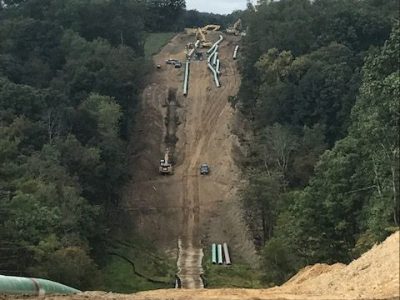Pipeline Installation and Current Use Taxation in New Hampshire
Would the installation of a pipeline pull the affected land out of the favorable “current use” valuation regime and cause it to be taxed more heavily?
Background
Northeast Energy Direct (NED) has applied to the Federal Energy Regulatory Commission for a license to install a natural gas pipeline across southern New Hampshire. The question has arisen as to the tax effect on an affected landowner under RSA 79-A, Current Use Taxation. The issue: Would the installation of a pipeline pull the affected land out of the favorable “current use” valuation regime and cause it to be taxed more heavily?
What is the Current Use Tax rule?
New Hampshire has declared in RSA 79-A that it is the public purpose of the state to encourage the preservation of open spaces as a means of promoting an “attractive outdoor environment for work and recreation” and to conserve “land, water, forest, agricultural and wildlife resources.” To that end the state has determined not to tax land at values “incompatible with open space usage” and to assess land at its “current” (open space) use, as opposed to its theoretical “highest and best” use. The value of land, as such, is assessed at the property’s value based upon its “income-producing capability” in its current use for growing forest or crops, not upon its fair market value.
What types of Land Uses are there?
For valuation purposes under the statute, a distinction is made between “farm land,” “forest land, “unproductive land” and “wetlands.” “Farm land” means cleared land capable of growing crops. “Forest land” means land growing trees. “Unproductive land” means land incapable of growing crops or forest because of poor soil or because it is rocky, steep, etc.
“Open space lands” can mean farm, forest or unproductive land. “Wetlands” are those areas of forest, unproductive or crop land that are inundated or saturated by surface water such they that support hydric vegetation. If land is deemed “unproductive” it is valued and taxed at the lowest current use value.
Who classifies the land? What values do they use?
The Selectmen or assessing officials are to appraise open space land—excluding buildings or other improvements— at valuations based upon current use values established by the Current Use Board established under RSA 79-A3. Farmland values flow from a board-established soil potential index.
What happens when the land use changes?
When the usage of land that had been classified as “open space land” changes, it is subject to a “land use change tax.” Pursuant to RSA 79-A:7, I, the LUCT is assessed “at the rate of 10 percent of the full and true value determined without regard to the current use value of the land which is subject to a non-qualifying use.” The tax is in addition to the annual real estate tax imposed on the property and is due upon the land use change. Once land has come out of current use valuation, it is taxed at its full fair market value under RSA 75:1.
What triggers a land use change?
A land use is considered “changed” when actual construction begins causing physical changes in the earth, such as building a road to service a new home or subdivision, or excavating a construction site. (It is noted that a land use is changed if excavated materials from the property are sold. Thus, where ledge is involved in the installation of a pipeline and it must be shot by dynamite, it should be specified in the right-of-way agreement with the pipeline company that it is the obligation of the company to dispose of shattered rock off premises—the landowner probably does not want to try to sell the debris for road fill….) Only land that is specifically affected is subject to the change tax. Under RSA 79A VI there are exceptions, however.
Land use is not considered changed if:
• Land under current use is taken by eminent domain or any other type of governmental taking which would cause the use change penalty to be invoked.
• Land abutting a site taken by eminent domain…upon which construction is in progress is used to stockpile earth taken from the construction site.
• Land accorded current use assessment in one category is changed in use to any other qualifying category.
• Land under current use assessment is eligible for conservation restriction assessment pursuant to RSA 79-B.
Does the installation of a pipeline trigger a land use change?
It would seem clear that where land (in this case an easement) is taken by eminent domain, no change in use occurs. The Natural Gas Act regulates interstate natural gas pipelines. Section 717f (h) of the Act provides:
When any holder of a certificate of public convenience and necessity cannot acquire by contract, or is unable to agree with the owner of property to the compensation to be paid for the necessary right-of-way to construct, operate, and maintain a pipe line or pipe lines for the transportation of natural gas, and the necessary land or other property, in addition to right-of-way, for the location of compressor stations, pressure apparatus, or other stations or equipment necessary to the proper operation of such pipe line or pipe lines, it may acquire the same by the exercise of the right of eminent domain in the district court of the United States…, or in the State courts….
What if the land was seized by eminent domain?
This presents the question as to whether a negotiated right-of-way under the “threat” of eminent domain—short of a litigated taking-in-court—constitutes a “taking by eminent domain,” or “any other type of governmental taking” within the meaning of the N.H. statute. It would seem that it does. Eminent domain is often referred to as an “involuntary conversion,” meaning, once a landowner is in the headlights of the government taking process, he/she is being forced to do something; taking is involuntary and absolutely beyond the control of the landowner. The inevitable road to the loss of property interest is straight and clear, though the ultimate process for determining compensation (negotiation or trial) is not yet determined. Negotiation is obviously favored as saving the resources of condemnor, condemnee and the courts.
The public policy of the New Hampshire law is echoed and amplified in I.R.C. Section 1033 (a), which deals with the tax consequences of an involuntary conversion of property into cash or other property. It reads:
(a) General rule: If property (as a result of its destruction in whole or in part, theft, seizure, or requisition or condemnation or threat or imminence thereof) is compulsorily or involuntarily converted….
The statute then provides that there is no tax recognition of the proceeds of the involuntary conversion, provided the landowner purchases similar property within a certain time frame. The point is that the federal statute accords recognition to the practicalities of the taking process. Most cases are settled short of trial; in fact, most often landowners negotiate a fair settlement with the government without a formal takings case being filed. It would seem under New Hampshire law that settling with a public utility, short of trial and even short of the utility filing suit should be seen as being in the eminent domain process and should not constitute a change in use. A practical tip: It is recommended that certain verbiage be incorporated into the easement agreement that reflects that the parties came to agreement in the face of the appropriation process that otherwise would have been forthcoming.
Assuming that a New Hampshire town would interpret this portion of the law otherwise, other relief from the change use tax is available. RSA 79-A VI provides further:
VI. For purposes of this section, land use shall not be considered changed and the land use change tax shall not be assessed when:
(c) Land accorded current use assessment in one category is changed in use to any other qualifying category.
What happens when a pipeline is installed in farmland?
In farm country, nothing. In other words utility easements typically do not forbid growing crops. Of course, most of New Hampshire is forestry lands. Yes, it is true that trees are not permitted to be grown on pipeline rights-of-way, but there is nothing to say that a landowner could not plant, for instance, blueberries. In other words the use would be changed from “forest land” to “farm land.” Again, RSA 79-A defines “farm land” as “cleared land capable of growing crops”—it does not say crops actually have to be grown.
Finally, RSA 79-A VI concludes:
VI. For purposes of this section, land use shall not be considered changed and the land use change tax shall not be assessed when:
(d) Land under current use assessment is eligible for conservation restriction assessment pursuant to RSA 79-B. Such land shall then be allowed to change from current use assessment to conservation restriction assessment with no land use change tax being applied.
Under RSA 79-B “conservation restriction” means a permanent restriction of open space land by deed granted in perpetuity… to a federal, state, county, local or other government body, or to a charitable, educational, or other nonprofit corporation established for the purposes of natural resource conservation…. A landowner contemporaneously with the grant of a pipeline easement in theory could grant to, for instance, a town an appropriate conservation easement co-terminus with the pipeline easement.
One final matter of note, a further reduction in the current use value of land is offered under RSA 79-A:4 where land is open 12 months of the year to recreational activity such as skiing or hiking.
Conclusions
In sum, where an affected property owner properly asserts his/her rights under RSA 79-A and 79-B, and where he/she correctly memorializes his/her interactions and agreements with NED the installation of its pipeline should not trigger the land use change tax.


